Fishing is a popular outdoor activity in many parts of the world. Whether camping for a week or simply escaping your urban surroundings for a weekend, fishing can be relaxing, exciting, and social if you partner up with a buddy or family member. An important part of fishing is learning how to string a fishing pole. Stringing your rod needs to be done before you can continue preparing your line with lures and weights. Only once this is all done, then you can cast your line. It is also important to understand that not all reels and lines are identical.
Fishing has come a long way and the types of equipment available today might make beginners feel a lot like a fish out of water. Fortunately, it’s not too difficult to make sense of it all.
Understanding different reel types
When learning how to string a fishing reel, you first need to establish the type of reel you plan to use. There are several different types of reels on the market, and each of them is suited for a particular type of fishing and fishing conditions.
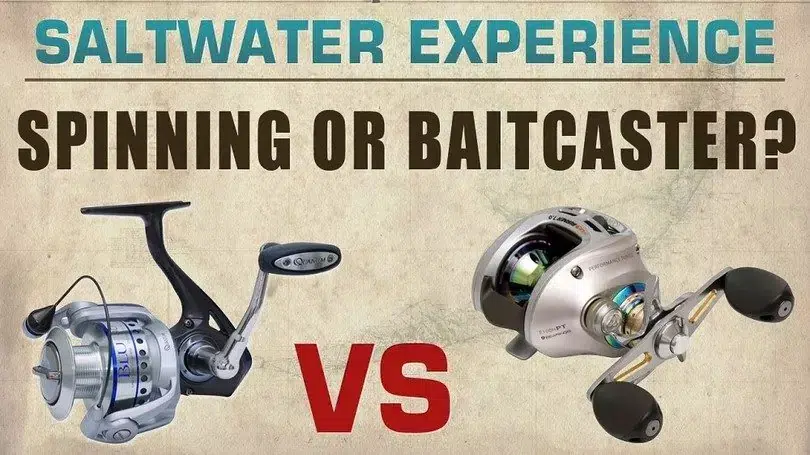
Fishing reels can be divided into three main groups: Spincast, Baitcasting, and Spinning reels. Spincast reels have a closed face because all of the components are tucked away inside a cone-shaped casing. The line comes out of the hole in the casing. This reel is easy to use but might not be as accurate or offer as much distance as some other options.
See also: Best Fishing Reels: Are Some Types of Fishing Reels Better than Others?
Baitcasting reels are tricky to get the hang of since the spool spins every time you cast. When in the hands of somebody with fishing experience, this reel is known to be highly accurate. Of course, the amount of skill required often results in first-timers turning to other, easier reels.
Spinning reels offer great accuracy, and they are easier to use than baitcasting reels. For this reason, these reels are the most popular of all. While baitcasting reels work great with heavier lines, lighter weight lines should be used with spinning reels.
Different types of fishing lines
Before taking the time to figure out how to spool a fishing reel, you will need to learn more about various types of lines available. Different types of lines are made to suit different types of fishing, different fishing conditions, and different fishing rods.
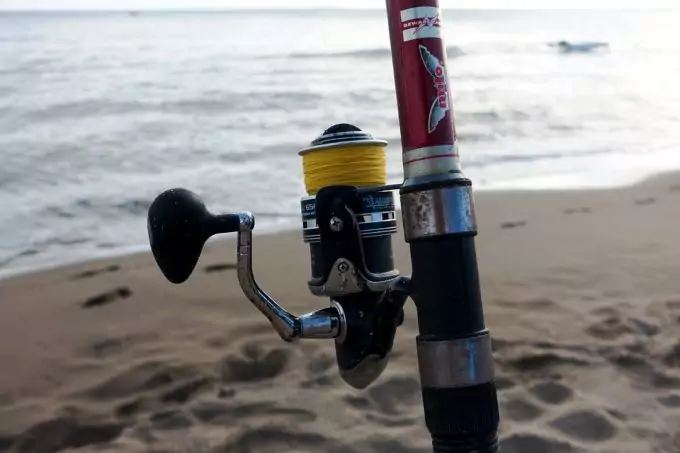
Braided lines have been around for thousands of years, and they were even used as far back as prehistoric times. They consist of multiple fibers that are woven together. However, back then they were quite thick and bulky. Today, Thanks to modern technology, braided lines are thinner and less visible in the water. There are various manufacturers, and some offer unfused braided lines that provide the same level of strength but are softer.
Monofilament lines are often used by beginners since they hold on to reel spools very well and don’t often slip within a knot. The materials used to make mono lines are less visible to fish which makes life that much easier. These lines offer more stretch, but they also have “memory” which means that, while stored on the reel, it takes on that rounded or curly shape.
Fluorocarbon is a relatively new line compared to those mentioned above. Its density and weight mean less slack. It also has less memory than mono lines, so it keeps a straighter shape. Experts recommend this particular line for baitcasting reels.
Fishing line care tips
Fishing is not just about casting off into the water but also mastering the art of learning how to string a fishing reel and how to properly maintain your fishing line so that it lasts as long as possible.
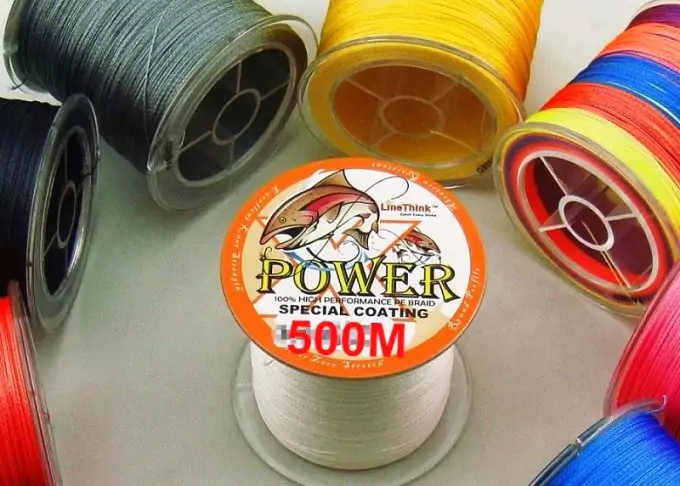
Keep these useful tips in mind in order to reduce the rate at which you need to respool:
- Don’t miss the eyelet. This might sound trivial and obvious, but many people accidentally run the line between the eyelet and the frame as opposed to through the eyelet itself. By making this mistake, you can cause serious damage.
- Tightly strapped lures that are left on the line during storage will weigh down on the line. As a result, the line will develop kinks.
- Wet your line when tying and untying knots. Failing to do so increases friction which creates heat and causes the line to become damaged and break.
- Check your line regularly for damage. Cheaper lines don’t normally last as long as higher end varieties. Also, you will find that braided lines are also some of the most durable on the market. That said, a thorough inspection of your line is important before casting off. Failing to do so could result in a great catch getting away.
- If you fish regularly, you are bound to experience some line overrun. Twists and tangles might be tempting to pick apart but take care when you do so, or you could create even more kinks.
Proper storage
While conducting research on how to spool a fishing rod, you will notice how many experts recommend that you follow the correct care and storage practices. By looking after your fishing line, you will ensure that it lasts as long as possible, and you won’t need to restring quite as often. Different types of line also need different kinds of treatment.
Fly-fishing lines need to be removed from the reel, wiped clean with a soft cloth (and special cleaner) before being lubricated with a special dressing. Hereafter, the fly line can be wrapped around a large plastic container (like a coffee can) to reduce memory and stored inside a cardboard box in a cool and dark area.
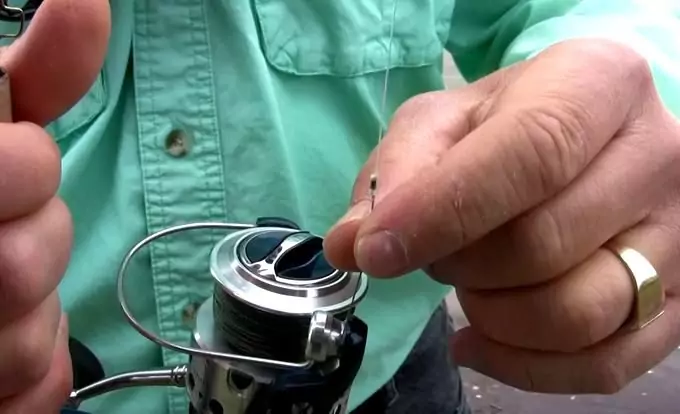
Monofilament and braided lines can be wound up on the spool, and a rubber band can be used to hold them in place. They should then be placed in a cardboard box, labeled and stored in a cool and dry place. Although you are winding them up on the spools, they should be would up loosely. To clean these lines, simply use regular dishwashing liquid.
[the_ad_placement id=”in-text-2-type-r”]Fluorocarbon lines should also be cleaned and treated with a specific lubricant and stored on the reel itself. The lubricant should be applied again before you head out on your next fishing trip. This time, however, instead of unspooling and respooling the line, you can simply spray the lubricant onto the reel and let it work as you drive to your favorite fishing spot.
Different ways of stringing reels
The method used to string your fishing line will depend on the reel you have chosen to use. Remember to choose the right line for your reel and note such important details, line length, and strength. If in doubt, consult with a professional to help you make the best possible decision to suit your personal needs.
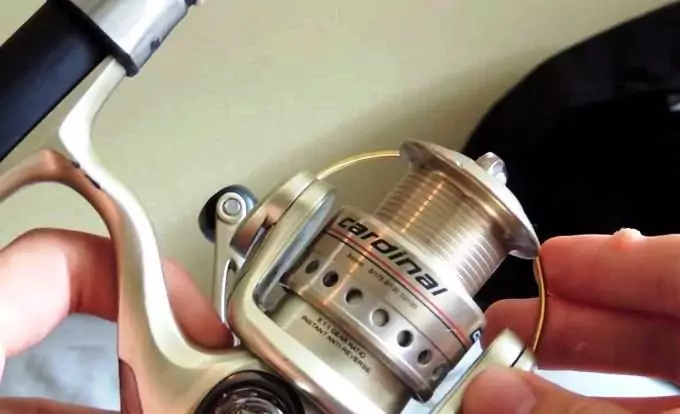
The strength of the line you choose is not only relating to the weight of the fish, but you should also consider the water currents. When fishing in stronger currents, you will need a tougher line that won’t break under the combined pressure of the water and the weight of your impressive catch.
How to string spinning reels
- Before you begin, check the direction in which the bale rotates. Some rotate clockwise and others rotate counter-clockwise, depending on the brand. Take a look at the new spool and check the direction in which it unwraps.
- Make sure that your spool unwinds in the same way as the reel rotates in order to reduce twists in the line. If they don’t match, just flip the spool over so that they do match. If you don’t do this, you can cause kinks in the line, and you will have trouble when casting off.
- Secure the new line onto the reel. Do this by lifting the bail arm and running the end of the new line through the guides on the rod that lead to the reel.
- Wrap the line around the reel once and tie a simple overhand knot around the main line.
- Now tie another knot close to the tip of the loose end to prevent the line from coming undone.
- Once the line is tightened around the reel, trip off the excess line from the loose end.
- Low diameter lines are best secured with electrical tape as opposed to bulky knots.
- Close the bail arm.
- Hold your new line between two fingers so that it maintains sufficient tension as you reel a few feet onto the reel.
- Now test to see if the line is being coiled in the same direction as the reel by tipping the rod towards the new spool on the floor. If not, you will need to start again.
- A good tip to remember is to use a soft, clean cotton cloth to hold the line. That way, you can reel as quickly as you like without hurting yourself.
- The reel should only be filled to approximately 1/8 inch from the rim.
In this video is shown how to spool a spinning reel.
Remember to watch it as many times as you need.
How to string baitcasting reels
- This is usually a two-man job if you don’t have a reel filling station.
- Place a pencil inside the new spool and ask somebody to hold it for you. Alternatively, you can use a reel filling station which you can buy from any tackle shop.
- Again, you will need to check the direction of the reel versus the direction of the spool and make sure that they match.
- Slide the line through the line receiver and pull the line all the way through.
- Tie and secure the line in place and trim off the excess line on the loose end.
- Secure the line between two fingers and you gently cast it off the spool and onto the reel. Remember to maintain a fair amount of tension so that the line is snuggly wrapped around the reel.
- Remember not to overfill the reel! Stop reeling once the line reaches approximately 1/16 inch from the top rim of the reel.
In this tutorial is shown how to spool a baitcasting reel.
And how to spool baitcasters to avoid birdsnests and line twist.
How to string spincast reels
- Start by checking the reel’s capacity, which should be printed on the reel itself.
- Remove the face of the spincast (or closed face) reel.
- Remove any remaining line before respooling.
- Make sure that the direction of the spool is the same as the direction that the reel rotates.
- Slide the line through the small hole in the face of the reel.
- Lift the bail arm before running the end of the line through the rod guides and to the reel.
- Secure the line to the reel by wrapping it around the reel and tying an overhand knot around the main line. Tie a second knot close to the tip of the free end to prevent it from coming loose.
- Cut off the excess line on the loose end.
- Screw the face back onto the reel before you continue.
- Holding the line between two fingers, keep it nice and taut as you reel a few feet on.
- Remove the front cone to check how much you have reeled on. It’s a good idea to leave about 1/8 inch from the top so that the reel is not overfilled.
- Screw the cone back on and run the line through the rest of the guides on your rod and you’re all set!
Check out how to re-spool a spincast reels.
Very useful tips from professionals.
How to string fly reels
- Start by applying your backing. Attach your backing by using an arbor knot. Thread the end of the line from the spool through the reel and take it all the way around. Make another knot on the loose end to prevent the initial knot from slipping or coming undone.
- Trim the loose end off the arbor knot.
- Spool the backing onto the reel while keeping the line taut between two fingers.
- Secure the end of the backing line to your fly line by using an Albright knot.
- Slide the spool onto a stick, pencil or similar object.
- Spool the fly line onto the reel but make sure that you leave some space so that you don’t overfill.
- Attach the leader line to the end of the fly line and you’re ready for action!
- Remember to always double-check your knots and make sure that they are secure and loose ends are trimmed before you continue. It is better to take the time to get it right than rush the job and end up with problems just when the fishing gets good.
Here you can watch video how to spool a fly reel.
And you must check and watch all our video above in the article. Very useful tips. Also check out our complete article on how to tie those fishing knots – a skill every angler should master.
Cheap versus expensive
When searching the web to find tips for stringing a fishing reel, you will also find information on different kinds of lines. Not all lines are made equal, and they are all priced accordingly.
A monofilament line has been used for over 80 years, and many fishing enthusiasts consider it a vital part of any fishing kit. These lines are the cheapest of all, but they are also the most susceptible to kinks and bends due to the memory. You might find that this line will need to be replaced more often than other stronger lines.
Fluorocarbon lines are originally from Japan, and they are almost invisible in the water which makes for excellent fishing. These lines are the top choice for fishing in clear water as well as high-pressure areas. These lines don’t stretch as much as mono lines which means that the memory is less, and they are less likely to bend and develop kinks.
They are also more resistant to UV rays which helps them last longer. These lines are more expensive than monofilament lines, but they won’t necessarily need to be replaced as often which means more fishing time before having to respool.
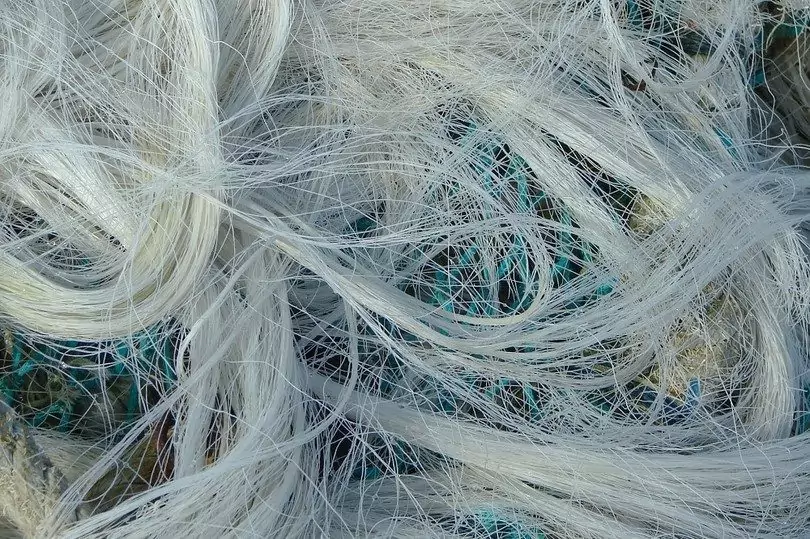
Braided lines can be less bulky than mono lines provided you select the right brand. The thinner the line, the better the sink rate, and these lines generally prove best for bait fishing. They are reasonably priced considering how long these lines last.
Conclusion
When fishing, it is always important to understand that the best way of spooling a fishing reel will depend on the reel and line you are using. Some lines require different knots, and there are also lines that are specifically suited for use with specific rods.
When buying your rod and reel, you might want to take the time to discuss your options with an expert. Explain your skill level, the intended use and where you plan to go fishing. With these in mind, a trained professional will be able to make the appropriate recommendations.
Keep in mind that many reputable manufacturers often offer giveaways and free samples. If you are unsure about a particular line and how it will suit your needs, you might be lucky enough to snag some for free or at a discounted price.
Before you go on your next fishing expedition, check out our review of the best baitcasting reel for more options.






I thank you for this practical guide. I began fishing as a hobby recently. I have struggled with the right equipment. Trying different brands, some good, some not so good, but I’m gaining more experience slowly. Next time I go fishing, I’ll make sure to remember the tips in that article.
Hey Patrick,
It’s always great to know that I have been able to share my experience and impart with it the knowledge that I had acquired. Skills are not something you can master overnight. Just keep fishing and applying tips and always do a debrief of what you’ve learned on your own. This helped me improve on my fishing skills and I hope it does the same to you as well.
Regards,
Andrew
Fluorocarbon lines are the best in my opinion. You get the value of your buck then but if you’re still getting used to fishing and on baitcasters, you can buy cheap ones so respooling won’t be too heavy on your finances. When you think you’re getting better, trust me, you won’t regret fluorocarbon lines. Good post.
You should always remember that an important part of fishing is learning how to string a fishing pole.
Great read! I have been wanting to try fishing as a hobby for a long time now, but I am afraid I might waste money without the proper knowledge. I’m glad that I have read your article. Can you recommend a starter fishing pole or the basics I must know before trying this hobby?
The Shakespeare ugly stik gx2 spinning rod combo is a good choice for a beginner. It can be used by both left and right handed fishermen and it’s built in one single piece. This rod is also fairly easy to string.
Hi Andrew, I am new to fishing and need recommendations. What “bang for your buck” fishing pole and string do you recommend? I am currently looking at the KastKing Ranger since it is on 50% sale on Amazon. What can you say about this product? Is it worth it?
I have tried different brands for the fishing line. Some are cheap, some expensive but there are those which stand out to me because they are durable, of good quality and can be bought at low prices. An example is fluorocarbon lines. They get the job done and get the best out of your money.
The KastKing Ranger telescoping travel spinning fishing rods are a good choice for a beginner. They are incorporated with essential features that a beginner fisher will definitely need to be successful. They are remarkably affordable.
Good choice, fluorocarbon lines are non-permeable to water. So, they will not absorb water throughout your fishing expedition. However, these lines have to be cleaned as well as treated with a reliable lubricant. You also have to store them the on reel after use.